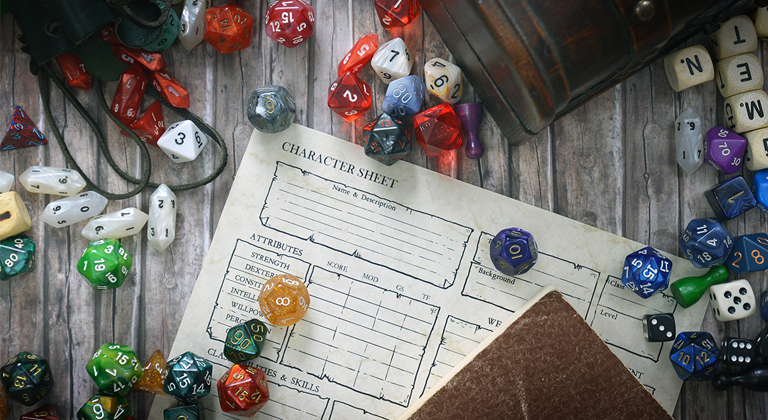Keep Your Sagas Consistent the Dungeons and Dragons Way
Writing a book series is a great way to establish a sustainable writing career – but the bigger your literary universe, the more difficult it becomes to keep track of it. Strong and recurring characters are the backbone of any great saga, but as your cast continues to grow, it becomes more and more difficult to keep track of everyone’s appearance, background and traits. So why not steal an idea from Dungeons and Dragons and use character sheets to keep it all straight?
This year, I published the tenth book in my most popular romance series and began adapting all the previous ones into paperback – and that’s when I ran across a problem.
In Book One of my series – the one I was turning into a paperback – I was reminded that my big, bad, baseball-bat swinging protagonist had an older brother.
In Book Nine, I’d specifically spoken about how he was an only child – and wouldn’t you know it, a reader picked up on that almost immediately.
In my article on Writing in the First Person Perspective, I explained how I managed to deftly solve that problem – but it highlighted to me how difficult it was to keep track of 19 main characters, each with a plethora of associated side characters.
My mother, who is also a writer, rolled her eyes at my predicament and told me to keep a Rolodex. Instead, I turned to what my Dungeons & Dragons-playing older brother once taught me: Character sheets.
If you’re writing a book series, Character Sheets are a hugely valuable tool to keep all the details of your characters consistent – and then whenever you’re uncertain, you have a binder full of Character Sheets so you can double check!
What is a Character Sheet?
In Dungeons & Dragons, a character sheet contains all the dice-rolling specs of a player character – a Level 20 Ranger with 12 Strength and 16 Dexterity (and a +2 bow, of course!)
In terms of your book series, it contains all the relevant data you need to keep track of – the stuff you want to keep consistent book to book, like eye-color, hair color, and – I speak from experience – whether or not they have a brother! Believe me, readers pick up on this stuff.
(I still haven’t forgiven Derek Robinson, author of Piece of Cake, for killing the commanding officer in one book, and bringing him back – as if nothing had happened – in the sequel.)
Here are some essentials:
- Full Name
- Nicknames
- Age
- Eye Color
- Hair Color
- Parents Names
- Siblings Names
- Children’s Names
- Place of Birth
- Education Level & Schools
Now, that seems like a lot – and don’t worry, you don’t need to fill them all in ahead of time. You just need to make sure that the first time that piece of information gets mentioned in your book, you do log it, so it becomes what Star Wars and Star Trek nerds (I’m both) refer to as ‘canon.’
For example, my baseball-bat swinging protagonist had his nickname, hair color, eye color, and approximate age mentioned in Book One of my series, but it wasn’t until Book Three (in which he was the main character) that I revealed his real name, place of birth, and the fact that he was a college dropout.
Each time a reoccurring character appears in your stories, write down any details we learn about them – and if you turn to your character sheet and find that information already listed, make sure it matches what you’re writing now!
Going deeper…
The basic biographical details are important, but my character sheets tend to go deeper. I’m very much into the Hemingway mold of writing, in which you find the single perfect word rather than using three or four adjectives, and I use my character sheets to record those key descriptive words.
For example, more important than the height and weight of my baseball-bat swinging hero is the fact that his gaze is “smoldering”, his build is ‘burly’ and he ‘lumbers’ when he walks, and his voice is deep but ‘theatrical’ because he’s a badass with an ego, who likes to put on a show.
These evocative keywords can become as useful as a character’s eye-color and place of birth, because readers also point out if a character was ‘burly’ in one book, and ‘ripped’ in another. Both words mean muscular, but ‘burly’ makes you think of somebody built like a bear, whereas ‘ripped’ refers to a shredded bodybuilder. Unless there’s a narrative reason for the physical change, you need to keep it consistent.
Some writers might balk at the idea of reusing the same key adjectives and descriptors again and again, but I argue that it’s almost a kind of poetry, and it makes those descriptors as valuable to identifying a character as their name.
One British police officer I created, for example, was described as “steely-eyed” and I was able to begin using that term interchangeably with his name, which meant you didn’t need to keep repeating “Detective Phelps said…” in scenes in which he’s talking with another guy. If I was to start a chapter with “The steely-eyed inspector strode into the room…” the readers would know which character it was because of my consistency with those use of adjectives (and they’d also complain that he was a ‘detective’ one sentence earlier, and now he’s an inspector.)
Obviously your own style of writing may or may not suit this approach, but I find it extremely useful and my readers have said that one of the things I do nicely is find a way to differentiate supporting characters and make them seem unique and individual without having to labor the point.
I tend to have a few boxes to store those adjectives in:
- External Features
- Internal Features
- Quirks
These are the distinctive things that make a character come to life, like the way Chief Inspector Teal from The Saint would constantly unfold and chew Wrigley’s gum, or how James Bond would eat scrambled eggs at ridiculous hours of the day.
These can really help bring the character to life in your mind, and on the page – and make writing about them seamless yet distinctive.
Inventory
In Dungeons & Dragons, one of the other reasons you have a character sheet is to record what equipment your character is carrying – that +2 bow, a bottle of healing potion, and an orc’s jockstrap, for example (not sure what the story with the third item is.)
I tend to like to include specific things in my stories, so Character Sheets are a good way to record them – like how the hero of my book EU Only Live Once drank gin and tonics made exclusively with Plymouth Gin and half a whole lime.
Likewise, Miranda Priestly from The Devil Wear’s Prada wears – obviously – Prada, and if I was Lauren Weisberger, I’d have jotted that down on a character sheet to make sure I didn’t have her slumming it in Emporio Armani in Revenge Wears Prada.
It’s also worth keeping a lack-of-inventory, depending on the fortunes of your heroes and heroines. Few will forget that scene in G.R.R. Martin‘s books in which the one-handed Jamie Lannister “cupped his hands” to call to his enemies. That might have been a detail worth jotting down (although with all the characters and brutality in the Game of Thrones series, you can’t blame G.R.R. Martin for forgetting a fairly minor case of amputation (and at least Jamie made it out better than Theon, although his ‘missing inventory’ was only hinted at in the books.)
Timeline of events and actions
Speaking of dismemberment, another valuable thing to include in a Character Sheet is a timeline – so you can keep track of a character’s past, present, and – in the case of G.R.R. Martin, at least – their lack of future.
For me, this became apparent the first time I wrote about my baseball-bat wielding hero having served ‘twenty years ago.’ In my head, that put him back in the 1980s. Unfortunately, I’d forgotten how old I was (but that conveniently put my hero in a position to have served in Iraq.)
You don’t want to have a flashback to a character’s past if he’s meant to be doing something else at the time, according to the timeline in another book.
It’s also worth listing the meetings characters hate – since you don’t want to write about a firm and manly introductory handshake between the hero of Book Four and the hero of Book Six and then remember that they’d both actually known each other in Book Two.
I prefer not to use specific dates in my stories (since it ages them rapidly) but on my character sheets I will – because it’s equally useful for being able to map out other things from that period when you embark on a flashback (yes, I was Googling ‘Top 10 pop songs in 2003’ not that long ago – don’t judge.)
Limitless opportunities for procrastination
The final thing that I love about making and assembling character sheets is that it’s a wonderful way to procrastinate without procrastinating. We writers are a crafty bunch, and despite writing being our purpose – we often do anything and everything to avoid it. A little arts and crafts with some character scrapbooking? That’s perfect!
But keeping track of characters like this has the inadvertent side-effect of helping develop them in your mind; and by treating them like celebrities you’re stalking, or sports stars you’re tracking for a Fantasy League, you’ll find they turn up during your writing time much more consistently.











